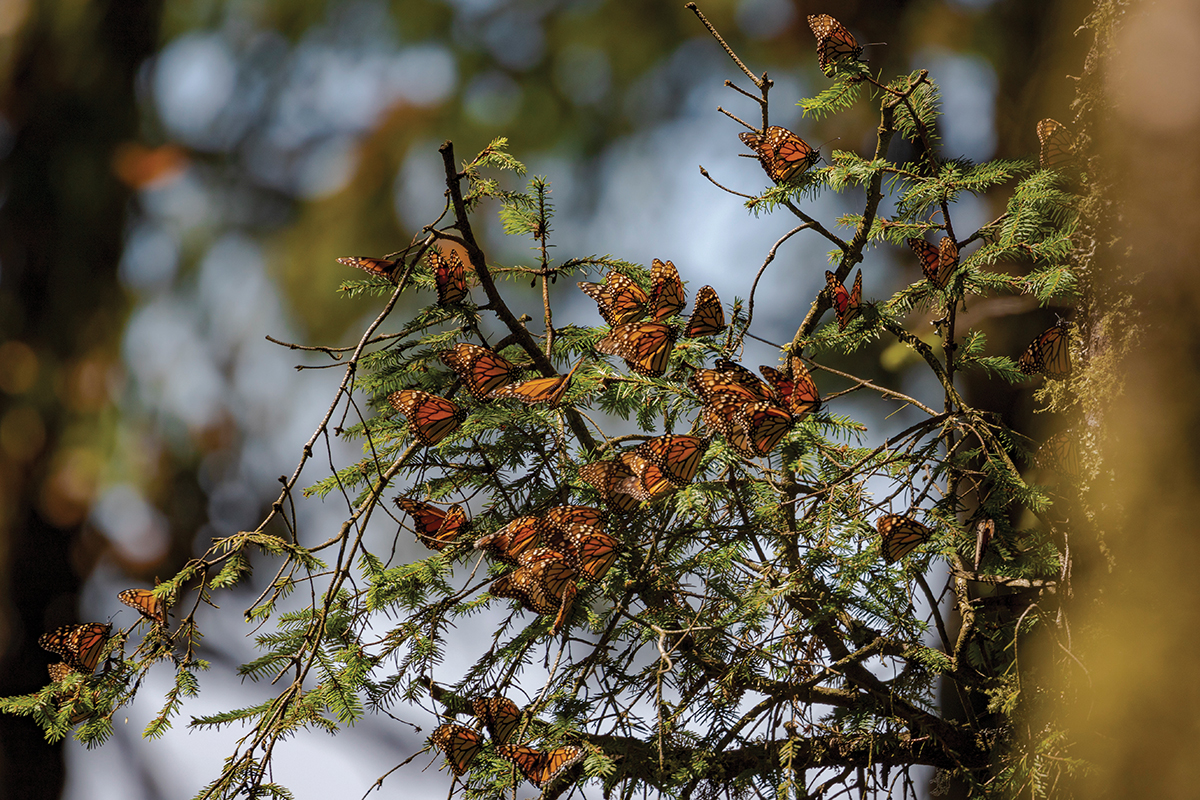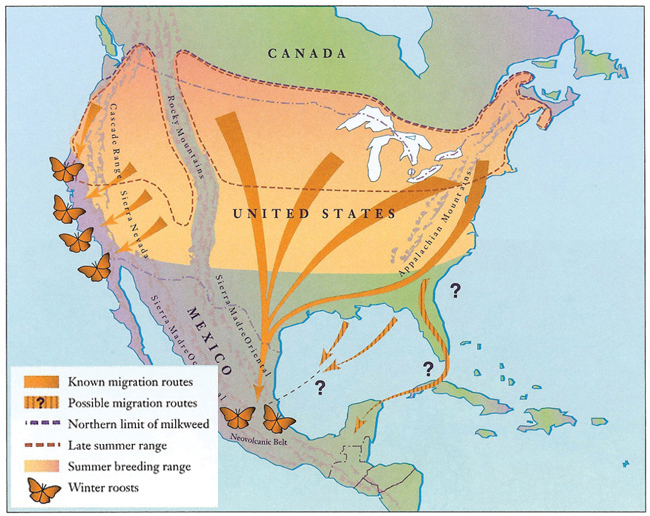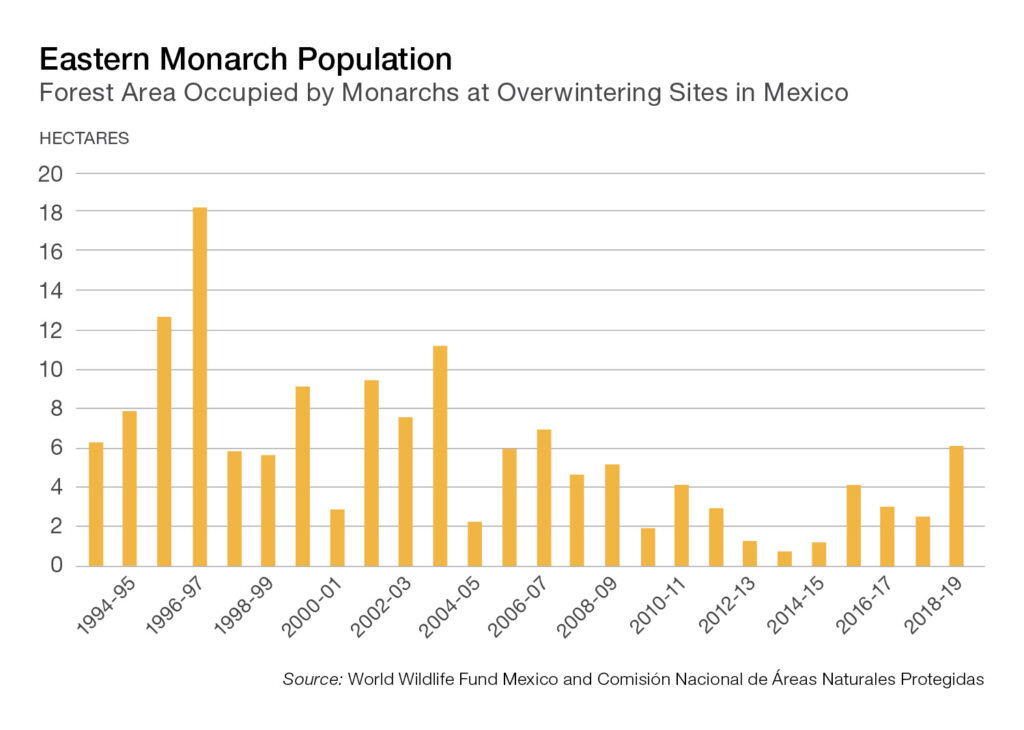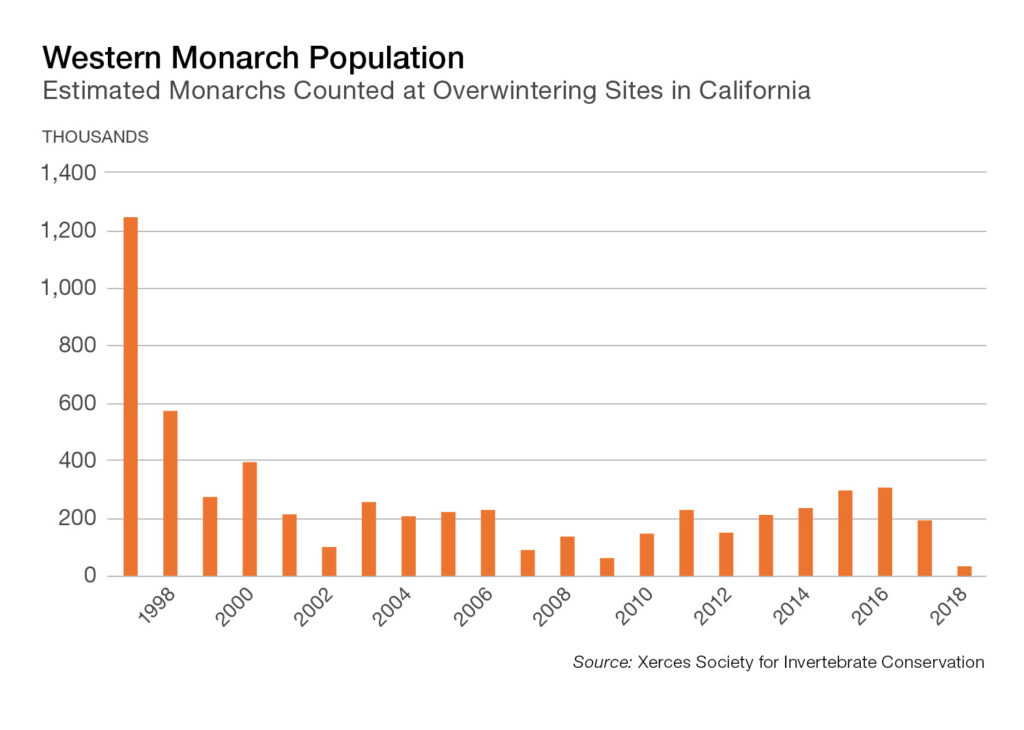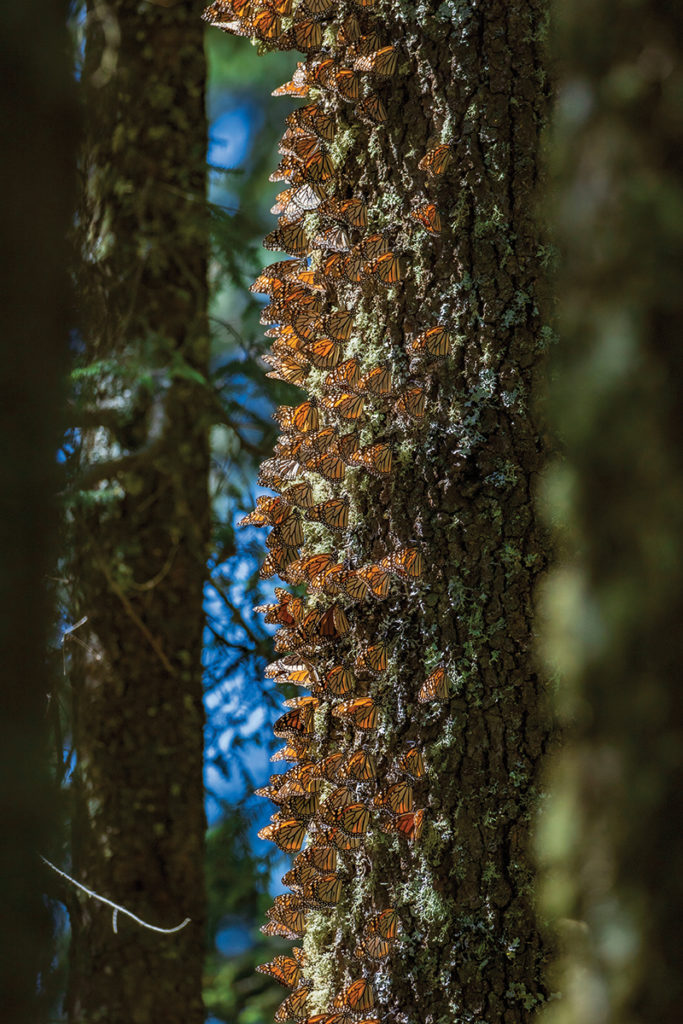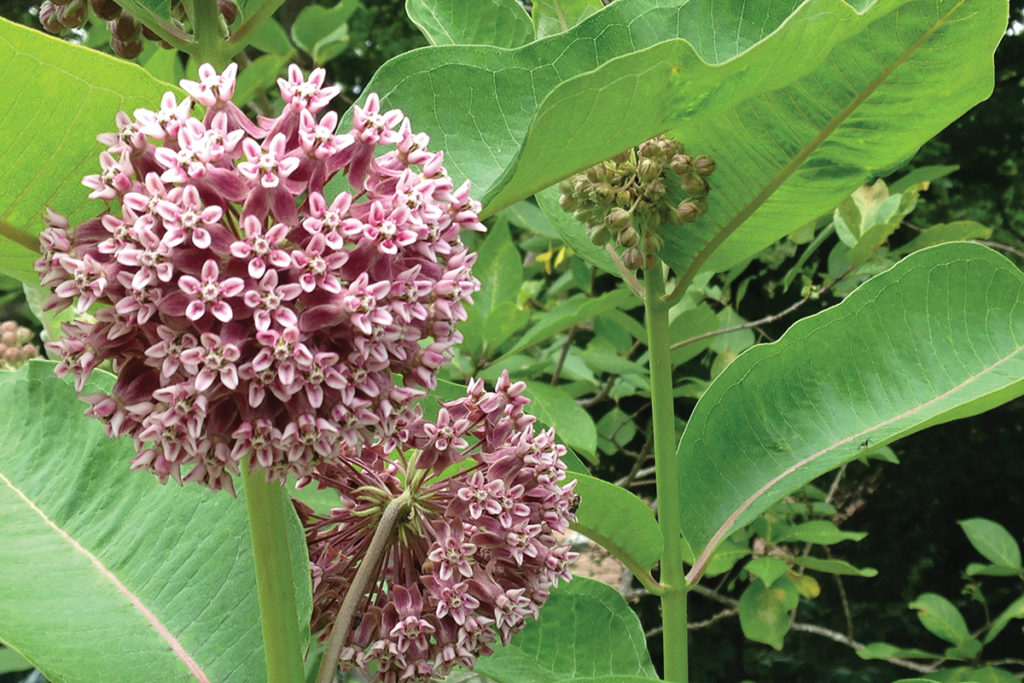In 1947, two Harvard students founded the Lepidopterists’ Society, a group formed to publish a periodical on lepidopterans—butterflies and moths—and facilitate “the exchange of specimens and ideas by both the professional worker and the interested amateur in the field.” The most iconic of all lepidopterans is perhaps the orange-and-black-winged monarch butterfly, found in every state except Alaska and known for its remarkable trans-continental migrations. A 19th-century account described the butterflies appearing in the Mississippi Valley in “such vast numbers as to darken the air by the clouds of them.”
Despite the renown of the insect, the first members of the society struggled to answer a seemingly straightforward question: “What happens to the butterflies that fly through Texas in the fall?” Scientific observations of the monarch’s migrations had been published dating back to at least 1868. Yet no one knew exactly where the innumerable butterflies went for the winter.
One of various hypotheses that were presented over the years was that the butterflies seen headed south were emigrants—one-way travelers that simply perished—and it was stationary female monarchs that somehow survived the Midwestern winter to reestablish populations each spring. A later theory posited that monarchs migrated eastward to the Gulf Coast of Florida, spending the winter in pine trees near Apalachicola. It took an amateur Canadian entomologist who had seen an adult monarch freeze to death on his windowsill to piece together the basics of the puzzle. He reasoned that if the winter freezes occasionally visited upon the Sunshine State were intense enough to destroy orange groves and kill overwintering bluebirds, there was no way that monarchs could survive such cold snaps. That meant the monarch had to spend its winters farther south, somewhere in the tropics. Eventually, geography and logic dictated that there was only one reasonable answer: Mexico.
On a January evening in 1975, an American transplant to Mexico City named Ken Brugger, who had been crisscrossing the countryside in a motor home searching for a monarch overwintering site as if he were a conquistador traipsing across the continent in search of a city of gold, relayed his discovery of the butterfly’s winter home. “We have found them,” Brugger told Fred Urquhart, a Canadian zoologist who devoted much of his career to studying the monarch, by phone. “Millions of monarchs—in evergreens beside a mountain clearing.”
Thanks to scientific inquiries that spanned generations of amateurs and professionals, we now know that every winter millions of monarchs pass the cold months roosting in oyamel fir forests of the Sierra Madre mountains in central Mexico. In some spots, they congregate so densely that they blanket virtually every inch of the trees. When they’re assembled in such flocks, they can be counted, which is how we know that this so-called “eastern” population has substantially declined over the past 25 years, losing perhaps 90 percent of its numbers. There is a smaller, western population of monarchs concentrated in California that migrates along a shorter path, from the coast inland toward the Rocky Mountains and back. Its population decline has been even more drastic than the eastern one. In short, the monarch does not darken as many skies as it used to.
The eastern population includes monarchs that can be spotted in the spring and summer in locales from Central Texas and South Carolina to Minnesota and Ontario and New England, and just about everywhere in between. And a little bit like the lepidopterists who study them, these butterflies stand on the shoulders of those who came before them. Of the eastern population, no single monarch makes the full migration; once the butterflies leave the Mexican forests, it takes four generations for their offspring to complete the annual trip north and back.
There is considerable year-to-year variation in butterfly counts, largely due to swings in weather, but the trend is downward for both populations. Various causes have driven the declines, but the primary one is loss of habitat—milkweed and other nectar plants. Monarchs lay eggs only on milkweed plants, which their larvae feed on exclusively. The caterpillars sequester toxins from the plant inside their bodies, making them poisonous to birds. The defense mechanism is one reason the butterflies can survive the winter in such extreme densities without becoming a buffet for predators.
In the Midwest, widespread adoption of herbicide-resistant crops over recent decades has taken its toll on butterfly habitat. While crop advances have been a boon for U.S. food production, they have also meant more spraying for weeds. That in turn means fewer milkweed plants that previously could have thrived in forgotten buffers around cornfields or along fencerows and in ditches. It also means fewer prairie nectar plants, which give adult monarchs energy to fuel basic metabolism as well as extended migration. Expanded use of pesticides is another threat to the species, as are extreme hot or cold spells partially attributed to climate change. Logging at sites in Mexico has also threatened the butterflies’ overwintering habitat in recent years.
All of these factors were part of a 2014 petition to list the species as threatened under the Endangered Species Act. A listing would be controversial given that the species is found throughout much of the world and is not under threat of global extinction. (Hawaii, for instance, is home to a resident population of monarchs.) Furthermore, listing a winged insect found throughout the continental United States could have sweeping regulatory repercussions for virtually anyone who might have milkweed or other monarch habitat growing on their property.
The fact that the monarch’s migration differs greatly from those made by ambulatory species such as elk or pronghorn presents opportunities and challenges alike. Unlike wildlife that requires wide-ranging terrestrial corridors in which each acre is connected to the next, monarchs need only occasional patches of milkweed and nectar to stitch together their migratory flyway. Yet that flowering habitat has to be dispersed across half a continent, meaning that a fairly large number of people need to be interested in the endeavor. Getting a little bit of effort—say, planting a few milkweed stems in the backyard—out of a disparate and collectively huge group of people can be a high bar to clear, even for a charismatic species like the monarch.
The U.S. Fish and Wildlife Service will decide whether to list the species, and in particular, the migrating North American populations that are in peril, by the end of 2020. But many groups, including ranchers, farmers, and conservation organizations, have already been at work trying to bolster the monarch’s numbers. While human activity has no doubt harmed monarch habitat, the impending listing decision could become a catalyst for humans to embrace monarch-recovery efforts—if the incentives to participate line up for landowners.
Pockets of Prairie
Despite its iconic status, in certain respects, the monarch is not unique. For better and worse, virtually all species have been affected by human activity. In early 20th-century America, for instance, federal and state governments and citizens carried out eradication efforts to get rid of many species then considered to be pests. Yet today, many have rebounded, often with farmers and ranchers becoming species’ best friends by providing habitat for once-decimated wildlife like deer and beavers. When it comes to imperiled species, private landowners provide most of the habitat for about half of all species listed as threatened or endangered.
The story of the monarch can partly be told in reverse. In some respects, the species benefited decades ago when humans changed eastern and Midwestern landscapes. As the late Lincoln Brower, an late American entomologist who chronicled the “understanding and misunderstanding” of the monarch’s migration and was one of the petitioners to list the butterfly, put it: “Plowing of the prairies together with clearing of the eastern forests promoted the growth of the milkweed, Asclepias syriaca, and probably extended the center of breeding from the prairie states into the Great Lakes region.” To be sure, much of the prairie vegetation that thrived prior to European settlement has long been lost to agriculture, and likewise, the diversity of milkweed species and assortment of nectar plants have diminished. But in the newly plowed and cleared areas, common milkweed—the Asclepias syriaca Brower referred to—proliferated. The transformed landscapes gave the plant a foothold along fencerows, buffers, and ditches that surrounded crop fields and in open meadows that replaced stands of timber. “This spread of A. syriaca into the opened forest areas,” wrote Brower, “was consistent with the fact that it is the one truly weedy species of the 29 native milkweeds in the monarch’s summer breeding range east of the Rocky Mountains.”
More recently, however, American farming operations have been less friendly to the butterfly and its habitat. One widely cited 2013 study noted the significant decline in agricultural milkweed that coincided with the uptake of crops resistant to the herbicide glyphosate, better known as Roundup. The researchers found that in the Midwest, there was a 58 percent reduction in total milkweed and an 81 percent decline in monarch production from 1999 to 2010. (Glyphosate-tolerant soybeans and corn were introduced in the late 1990s and had adoption rates of 72 and 94 percent by 2011, respectively.) It’s this type of damage to monarch habitat, however, that has started to mobilize some farmer-conservationists to take action.
“The monarch butterfly migration is just amazing to me,” Tim Richter, manager of a corn and hog farming company that operates in Iowa and Missouri, told farming news outlet AgWeb in July. “How far they travel, that they can’t get very far without nectar sources, and that eating milkweed makes them toxic to other animals.
“I live and farm in a region that is critical to the monarch’s survival,” he says, “and I wanted to help.” Richter is planting milkweed around hog barns at three different sites, something that he says was made cost effective partly because the nonprofit Environmental Defense Fund supplied the seeds. (Not having to mow the four acres, he adds, will save money too.)
It’s an example of various efforts EDF is making to encourage farmers to grow a new crop: milkweed. Providing seeds is one small aspect of the strategy. A much larger component is the Monarch Butterfly Habitat Exchange, which the group has helped establish with a handful of partners. The hope is that, eventually, parties interested in funding monarch recovery will be able to pay farmers and ranchers to restore or enhance milkweed and nectar habitat.
“What we’re finding is that just about everybody has that corner of property that could become habitat. The question is, what will it cost? And is there an incentive mechanism that can help pay for it?”
“Our strategy is to get the agricultural community in the center of the country to enhance habitat for the monarch in a voluntary way,” says Eric Holst, associate vice president for working lands at EDF. “We’re not looking to take land out of production but instead looking to piece together nooks and crannies of habitat where feasible.” He adds that EDF believes agricultural areas could provide about half of the habitat that needs to be restored—which the organization pegs at 1.5 million acres—to push the monarch toward recovery.
Holst points out that while vast expanses of Midwestern prairie large enough to support bison, large-scale fire, and ample butterfly habitat may be lost to history, dispersed plots of “surrogate prairie” are easier to come by. “These are small plots,” Holst says, “but have some of the ecological attributes of native prairie. It might be a quarter acre, or an acre or two, in parts of the agricultural landscape that are less valuable for production. Roadsides, ditches, the corner of the field that’s hard to get to—places where habitat might be the higher and better use than wheat or corn for your operation.
“What we’re finding,” Holst adds, “is that just about everybody has that corner of property that could become habitat. The question is, what will it cost? What will it cost in terms of money, time, manpower, diesel, and is there an incentive mechanism that can help pay for it?” So far, that’s been a tough question to answer. EDF has looked to public funding sources, but according to Holst, many government cost-share programs like those funded through the Farm Bill are oversubscribed. To expand options, the group is also looking to private investors, as with a pilot project with pork producer Smithfield, to expand options. The pilot, in northern Missouri, is using a $300,000 investment from the company to plant 1,000 acres of milkweed and wildflowers.
Another strategy EDF is considering is to package monarch habitat restoration with “stronger drivers,” as Holst puts it, such as water-quality improvement projects. He mentions the Raccoon River, a watershed for the city of Des Moines, as an example. The city has incentives to work with upstream farmers to decrease runoff and invest in wetland restoration, thereby improving water quality. If milkweed and other native nectar plants could be part of the package of planting vegetation buffers, for instance, then the city could improve the quality of drinking water for residents while adding monarch habitat at the same time.
“There’s tremendous desire to restore and enhance habitat,” says Holst, “and it’s fairly easy. It’s not like trying to restore a longleaf pine forest that’s going to take 200 years. On a plot that used to be planted in soybeans, you can have a good prairie plot in one year. And then you enhance breeding habitat for monarch, but that same habitat is valuable to a whole fleet of other species—pollinators, nesting birds, and other critters.”
Despite long-term population declines, the fate of North American monarchs isn’t set in stone. Rewarding people in a prime position to help bolster habitat might be the best hope for the butterfly to thrive once more. That could mean schemes like the fledgling EDF exchange that can pay farmers to grow milkweed and other flowering habitat. It could also mean enlisting city dwellers. “The interesting thing about the monarch,” says PERC research fellow Jonathan Wood, who has worked extensively on endangered-species policy, “is that most people can contribute to its recovery. People in cities can put in butterfly gardens. You can’t do that with the grizzly bear or the gray wolf.” A 2019 study estimated that metropolitan areas could potentially provide up to 31 percent of the milkweed needed for eastern monarchs to rebound. “While the ag sector and farmers will need to be the backbone,” Wood says, “you can work toward recovery without relying exclusively on rural areas.”
Recovery Threats
Ultimately, “soft” incentives to aid monarch recovery could end up being just as crucial as monetary ones. A main appeal for landowners, as with many listed species, would be the potential to avoid certain regulations that would normally accompany the listing of a species as threatened. Earlier in 2019, the Interior Department made changes to the way it implements the Endangered Species Act, notably repealing the “blanket” rule that automatically extended endangered protections to species listed as merely threatened. Instead, the Fish and Wildlife Service will tailor protections to each threatened species on a case-by-case basis.
The change restored the original distinction between the two types of listings as envisioned by Congress when it passed the 1973 act—a tweak that some decried as “gutting” the statute. Yet the monarch could demonstrate how more precise and targeted protections, rather than the rules that have indiscriminately covered all threatened species in the past, could help align the incentives of farmers and other landowners with imperiled species and ultimately promote recovery.
How likely are farmers and others to plant milkweed if they know it could attract swarms of butterflies that might come with restrictions on how they could use their land?
Before the rule change, if the monarch were to be listed, the mere presence of the butterfly or milkweed habitat in a cornfield might preclude a farmer from cultivating the area entirely—a state of affairs unlikely to foster goodwill between butterfly and farmer. The updated rule will mirror the way that the Commerce Department has tailored protections for marine species for decades. While protections will be customized to fit specific species under the new rules, if a threatened species’ status were upgraded to endangered, it’s likely that much stricter regulations would be triggered. Landowners, therefore, would have every incentive to help recover the species before it was too late. Similarly, landowners would know that regulatory burdens would be relaxed if a threatened species rebounded to the point of delisting, giving them a tangible and substantial reason to take part in recovery efforts.
If the monarch needs 1.5 million acres of additional habitat to rebound, how likely are farmers and others to plant milkweed if they know it could attract swarms of butterflies that might come with restrictions on how they could use their land? Conversely, a targeted rule for the monarch could provide farmers the assurances and encouragement they would need to plant milkweed, grow nectar, and help the species recover, all without risking land-use regulations that might normally accompany the presence of a listed species. And if a wide-scale and fluid exchange could one day even pay landowners to plant habitat for the butterfly, there’s a much better chance that they would become collaborators in conservation of the species.
A flexible threatened-species protection that’s tailored to the monarch could theoretically complement conservation efforts like the one that EDF is experimenting with. Enrollment in voluntary programs like the habitat exchange could become the mechanism by which regulators grant assurances or relief to farmers and ranchers. For instance, the Fish and Wildlife Service might exempt enrollees from the Endangered Species Act’s strict “take” prohibitions, which can unduly restrict all sorts of everyday land-use activities that pose little or no threat to a listed species or its habitat.
The 2019 estimate for the eastern monarch population showed an increase of 144 percent from the year prior, but the jump was largely attributable to a one-off cycle of perfect weather for the species. Only time will tell whether favorable conditions will repeat and sustain populations enough to keep them off the threatened list. Time will also tell whether the agency’s listing decision—and potential species-specific protections—will support or impede the type of voluntary conservation efforts that will be so crucial to the butterfly’s recovery prospects.
“There’s a challenge in that you need a little bit of habitat everywhere,” says Holst. “It’s not the same as specific, mappable corridors where you know where your blockages and barriers are. Monarchs stand out in the entire eastern United States. That doesn’t mean you need to turn the entire eastern United States into a wildlife refuge, but you need pockets of habitat everywhere.” If conservationists and policymakers can get the incentives—and rules—right, then more landowners will be enlisted to help the butterfly in coming years. Perhaps then, clouds of the most famous of the lepidopterans will darken the air once more.
